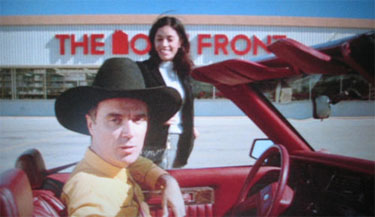|
|
Chapter Two: True StoriesBy Brett BeachDecember 9, 2010
There are nine featured songs in the film: six are performed by cast members, one is a lip-synch at a club to a “Talking Heads” song, another is a music video/commercial featuring the members of Talking Heads performing/becoming a commercial themselves and the last is performed by the band over the closing credits. Initially, there were going to be two soundtrack albums: Sounds from True Stories, with instrumental pieces (there are over a dozen) and a few other minor songs with vocals; and an album featuring the songs as performed by the cast members. The former did come out but only on cassette and LP - it has never been released on CD - and the latter was scrapped in favor of an album featuring all nine songs being performed by Talking Heads. Thus, it is not technically a soundtrack but it is the weakest of their eight studio releases. There is an unfettered joy in the performances by the mostly non-professional singers: John Goodman’s country-tinged growl on “People Like Us”; Annie McEnroe’s lighter than air quiver on “Dream Operator” and John Ingle’s spoken/sung throaty rasp delivery of “Puzzlin’ Evidence.” The menagerie of faces lip-synching along to “Wild Wild Life” suggests an early form of karaoke and the communal nature of passing the microphone off after a line or two reinforces the sense of community (odd though it may be) that Byrne has infused the film with. It is indeed the same joy of performance that Jonathan Demme bore witness to in filming Stop Making Sense. For the longest time, I have bemoaned the beyond bare-bones DVD release of True Stories. No menus, no extras, full screen. For a cult film with a highly visible presence 25 years after its release to be treated so shabbily remains insulting to me. But with the chance to have seen it in the theater in 2002 in Brooklyn, with Roger Ebert interviewing Byrne, taking questions and then screening the film, it must be said that Ed Lachman’s cinematography does not suffer from being seen on the small screen.
|

|
|
|

|
Friday, November 1, 2024
© 2024 Box Office Prophets, a division of One Of Us, Inc.


